
9 minute read
INCREASING PRODUCTION OF RESEARCH GRANTS Water and Aquatic Resources
by IFS
Water and Aquatic Resources includes the availability of water resources, and their conservation and use; freshwater, brackish and marine aquatic organisms and their environments and exploitation through fisheries and aquaculture; and issues associated with water-related institutions.
DR WILLIAM WILSON ANKU, GHANA
InoTechWater: Innovative and low-cost technology for fluoride removal from water
The InoTechWater project is intended to improve access to safe water by communities using fluoridecontaminated groundwater in Ghana by developing a simple, efficient and cost-effective point-of-use water treatment technology for household and community use. The development of such technology is necessary because groundwater has become the primary source of safe water in most parts of Ghana due to surface water pollution through indiscriminate gold mining activities. The existing foreign treatment methods are too expensive for the ordinary person while the tested locally developed methods are ineffective. The treatment agent will consist of Ca and Mg nanoparticle-modified activated biochar incorporated into porous calcium alginate beads (Ca-Mg/ABC@ PCAB) to be synthesised using agroindustrial wastes. Utilising such a device will ensure easy access to safe water, alleviate the detrimental effects of unsafe water consumption on the well-being and economic productivity of people in Ghana and Africa with similar problems, and support SDG 6.
MR DÉLAGNON ASSOU, TOGO
Ichthyological communities in Togo’s coastal lagoon system: Diversity, ecology, and exploitation
Fisheries are an essential natural resource for the Togo national economy, and a significant income-generating activity for many households living around these resources. In fact, fish represent one of the most utilised components of biodiversity, and if well managed, can contribute towards achieving the United Nations’ Sustainable Development Goals. Despite the benefits that local communities derive from fish, they are threatened on the one hand by climate change and on the other by human activities that limit their conservation. The proper management of fisheries resources requires a good knowledge of biological and ecological parameters of this critical biodiversity component, and of the impacts that human activities and climate change is having on the natural stocks to ensure sustainable utilization. In Togo, scientific data on fish and fisheries are currently minimal. To understand and improve the scientific knowledge of the biology, population ecology, and seasonal variation of fish communities in Togo’s lagoon system, it is essential to study the diversity patterns, community characteristics, and ecological drivers of fish assemblages in the lagoon system, and thus to provide a sound basis for decision-making that can aid future conservation planning and sustainable use of fishery resources.
DR ENOCH BESSAH, GHANA
Co-production of integrated indigenous and scientific weather and seasonal climate forecast for water resources management and food production in the Pra River Basin of Ghana
Climate variability and its impacts on the agriculture system are evident in Ghana. The weather and seasonal climate forecast information service has been in operation for some time in the country. However, findings from initial work in the Pra River Basin show that only about 30% of farmers have access to weather forecasts which most of the time fail. Therefore, the information is not helpful for farm-level decisionmaking. This has led to the reliance of the majority of farmers on their indigenous ecological knowledge to predict weather and seasonal climate patterns for farm-level decision-making for water resource management and food production. This study aims to improve climate information services through the co-production of farmer and scientific forecast systems. A multi-method research approach will be adopted, consisting of social participatory methods, mental modelling methods, forecast verification methods, and the principle of citizen science for data gathering and analysis. Results are expected to show the timing of climate information needs for farm-level decision-making and the contribution of indigenous forecasts in improving model-based seasonal forecasts to provide relevant information at farmers’ most preferred lead time.
MR LUIS GUIZADA DURAN, BOLIVIA
Understanding the Bolivian bufeo (Inia boliviensis) use of lentic habitats (lagoons) during a hydrological cycle in the middle basin of the Mamore River
The Bolivian river dolphin or bufeo (Inia boliviensis) is one of the four South American river dolphin species restricted to freshwater. Endemic to the upper Madeira basin in the Bolivian Amazon region, this species is categorized as “vulnerable” by the Bolivian Government and is a high priority for conservation due to human activities rapidly reducing its populations. We will study riverine habitats within its main distribution, leaving aside equally important habitats such as seasonal and permanent lagoons that host important dolphin populations and vary according to seasonal hydrological changes. Using standardised zig-zag transect methodologies and drones, habitat use in lagoons will be determined during different hydrological seasons, to determine annual variations in usage. All the information obtained will respond to the current needs of the action plan for the conservation of the bufeo in Bolivia (2020-2025), continuing with information for the Bolivian natural heritage.
DR MUHAMMAD YOUNIS KHAN, PAKISTAN

Geophysical and geochemical characterization of Hazar Khwani open dumpsite at Peshawar, Pakistan: Implications for soil and groundwater management
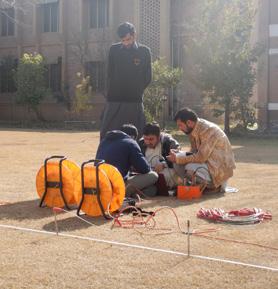
Peshawar basin comprises quaternary fluvial and lacustrine sediments and is the largest in Pakistan’s southern foothills of the lesser Himalayas. The basin is drained by three major rivers, significantly impacting agriculture, hydrology and the environment. Due to unplanned urbanisation, heavy transportation loads and high rates of industrialisation, there has been a dramatic increase in contamination. The Peshawar metropolis, in particular, poses severe threats to human and animal life. The rapid growth in population resulted in several challenges, e.g., the municipal solid waste (MSW) management across the globe and developing countries such as Pakistan where open dumpsites are considered a cheap source for MSW disposal. In this regard, the Illegal dumping of waste and subsequent environmental contamination is becoming common and problematic worldwide. A multi-disciplinary approach is appropriate to characterise dumpsites, combining near-surface geophysical and geochemical methods. This proposal will use Hazar Khwani as a study site in Peshawar, Pakistan. Based on the proposed integrated approach, the derived results will enable us to produce an optimised workflow and protocols to investigate such open dumpsites in Pakistan’s immediate surrounding residential areas.
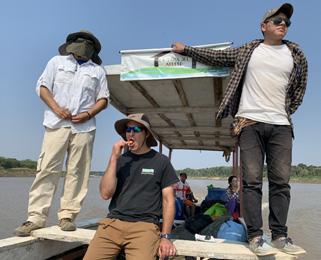
DR JOSIAH KUJA, KENYA
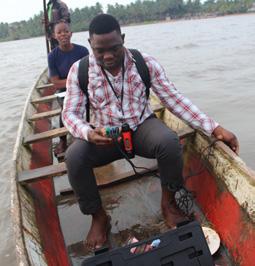
Comparative genomics: Spatial-temporal analyses of the dominant cyanobacteria and proteobacterial species across Lewis Glacier and its foreland in Mount Kenya
Lewis Glacier is one of the existing glaciers on Mount Kenya that is rapidly reducing in size by melting due to climate change and warming. The phenomenon threatens the loss of novel biodiversity that can be a bioprospecting resource to cold-active enzymes and freeze-resistant proteins that can be used as cryoprotectants in food and pharmaceutical industries. The initial study on Lewis Glacier revealed abundant cyanobacteria and proteobacteria across the glacier and its foreland. Consequently, their abundance was associated with reduced glacial surface reflectants, hence increased surface heat budget and subsequent melting. Cyanobacteria and proteobacteria phyla are known for their significance in the history of earth’s evolution and they remain novel candidates for bioprospecting from the equatorial Lewis Glacier. The proposed research aims at in-depth analyses of the genomic sequences of the known genera of phylum cyanobacteria and proteobacteria using global computational databases for metagenomic assemblies and genome annotations to reveal the significance of the cold-active enzymes and antifreeze proteins. These approaches will contribute to the African BioGenome Project’s databases for identifying and bioprospecting natural products for industrial utilisation.
DR RODGERS MAKWINJA, MALAWI
Elephant Marsh wetland ecosystem services under changing catchment: Implication on management and restoration effort
Elephant Marsh is ranked among the most vulnerable wetlands in Malawi, experiencing massive degradation of ecosystem services (ESs) instigated by rapid population growth, increased poverty, landscape transformation, climatic drivers, and over-exploitation, hampering the effort to achieve the SDGs. The study’s first objective is to quantify the land use/land cover (LULC) dynamics’ implication on Elephant Marsh ecosystem service value (ESV) from 1989 to 2019. This objective will depict the current trend and vulnerability of each ES due to landscape transformation to encourage policy-makers and various stakeholders to undertake action to reverse the situation. The second objective will use the contingent valuation method (CVM) and logistic regression model to determine the public’s willingness to pay (WTP) for future wetland ecosystem restoration projects and the influencing factors. This objective aims to assess how local communities embrace the local governance system to manage the wetland effectively. It further integrates science into the policy framework to achieve a sustainable ecosystem services (ESs) flow and help policy-makers develop practical and relevant policies and make science-based decisions to respond to local challenges.
DR JOHN MBAKA, KENYA
Applying citizen science in biomonitoring of selected riverine ecosystems in Kenya Globally, environmental organisations are enhancing their utilisation of citizen science to increase their potential to monitor and manage the environment at large spatio-temporal scales. However, there is a scarcity of information on the application of citizen science in environmental monitoring in Kenya. The objectives of the study are to evaluate the effect of land use and seasonality on physico-chemical factors and invertebrates in selected streams in Kenya; assess the reliability of invertebrate data collected by citizen scientists in differentiating study sites based on the type of land use and season; and determine the relationship between data collected by a university lecturer and schoolchildren. The study will provide vital baseline information to Kenyan environmental organisations about the usefulness of citizen science in environmental monitoring, and the potential for its integration with state freshwater biomonitoring programmes and policies.
DR SAFINA MUSA, KENYA
Estimation of nutrient loading in the wastes of Nile tilapia reared in cages in a eutrophic lake
Carried out fundamentally in open systems, cage culture-derived nutrients may exacerbate the quality of lacustrine environments. Despite the rapidly increasing trend in cage fish farming in the tropical/subtropical regions, there is a paucity of information on estimates of nutrient loads deposited in the environment from cage aquaculture. Yet, developing sustainable and environmentally-friendly aquaculture requires estimating the amount of waste associated with such systems. This study will use a mass balance model to estimate the nitrogen and phosphorus loads released into the aquatic environment from Nile tilapia cage aquaculture fed on soybean meal-based diets supplemented with different levels of phytase enzyme in Lake Victoria, Kenya. The findings will guide policy formulation towards the development of aqua-feeds with minimal environmental impact. The study will also be a step towards determining the ecological carrying capacity of cage culture sites as every ecosystem has a maximum assimilative capacity.
DR JEAN CLAIR NGOAY-KOSSY, CENTRAL AFRICAN REPUBLIC
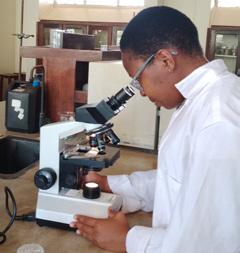
Planktonic diversity and physicochemical of Crocodiles Lake (southwest Central African Republic)
Knowledge of the resource and the assessment of needs are essential prerequisites for a comprehensive and balanced management of aquatic environments. Few studies have been undertaken on aquatic ecosystems in the Central African Republic. This project is a hydrobiological study of Crocodiles Lake located in the southwest of the Central African Republic. This lake, which is a tourist site, has no scientific database and is famous for the presence of crocodiles. The study concerns planktonic diversity, excellent bioindicators of lake environments, in relation to the physicochemical characteristics of water. The objective is to determine the ecological state of this lake to put in place a master plan for its watershed.
At the end of this study, a database on the morphology, physicochemistry, diversity of planktonic organisms and the ecological state of the lake will also be known.
MS THI MAI NGUYEN, VIETNAM
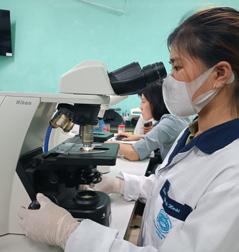
Study on the effect of dietary peptidoglycan and probiotic on growth, feed utilisation, immune response, and pathogen resistance in striped catfish Pangasianodon hypophthalmus
The striped catfish Pangasianodon hypophthalmus is an economic fish species in Vietnam and elsewhere in the world, providing a large amount of fish for human consumption. However, the farming of this species has recently coped with many problems due to disease outbreaks and the consequences of the indiscriminate use of antibiotics. The fish immune system could be stimulated by exogenous agents including probiotics, immunostimulants, and other bioactive compounds. Peptidoglycan is an important component of positive gram bacteria, and has been reported to act as an immunostimulant in mammals. However, the data on fish are still limited, and no results have been documented in striped catfish. This study will assess the effect of use alone or combined with dietary peptidoglycan with probiotics on striped catfish’s growth performance and health status.
MS ANNA OTIENO, KENYA
Aquatox modelling of the influence of land use and land cover changes on water quality, macroinvertebrates and macrophytes distribution in Ondiri swamp, Kiambu County, Kenya
Wetlands play an essential role in water quality regulation and flood control as well as support of biodiversity, yet are facing severe threats from land conversion driven by anthropogenic pressure. This study assesses land use types and land cover changes around Ondiri swamp, a major Nairobi River source facing unprecedented threats from commercial and agricultural practices. The broad objective of the study is to assess the current and future impacts of land use and land cover changes on water quality, macroinvertebrates and macrophytes of the Ondiri swamp. The specific objectives are to assess the land use and land cover change over a period of thirty years (1990-2020); determine the correlation between water quality and macroinvertebrate and macrophyte composition in Ondiri Swamp; evaluate the impacts of land use and land cover changes on water quality, macroinvertebrate and macrophyte composition of the swamp; and predict future land use and cover change impacts on water quality using the Aquatox model. Conclusions and recommendations regarding the suitability of the model will be drawn.







